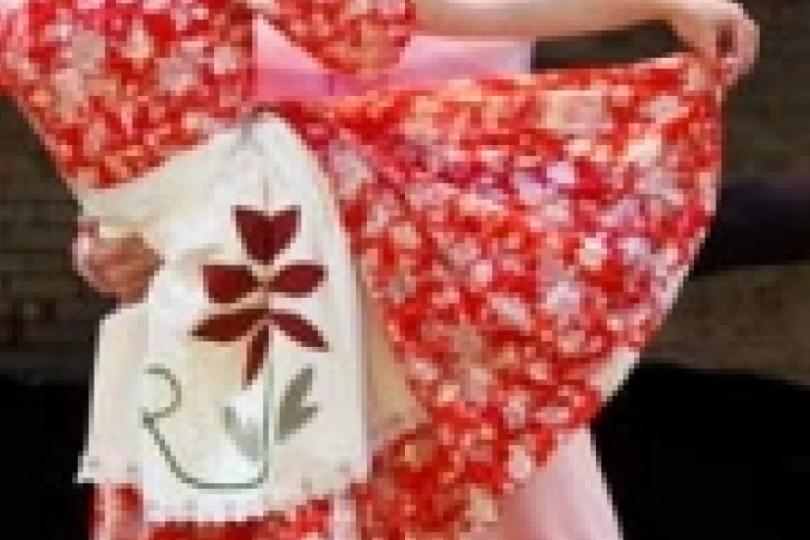Mother Goose and her dancers
Editorial

In its fourth season, Zenon’s inventive Nutcracker According to Mother Goose is basically a kids’ show, while Ballet of the Dolls’ Nutcracker: The Lost Act! (reviewed for MinnesotaPlaylist last week) clocks in as decidedly adult fare. But their choreographers—Seán Curran and Myron Johnson respectively—share an ingenious ploy: taking familiar music from Tchaikovsky’s Nutcracker ballet and doing with it as they will. Not that this is some new post-modern conceit; companies all over the world have shoehorned the Nutcracker ballet into various frameworks, from a Dickensonian orphanage (Matthew Bourne), to a football game (Salt Lake City), to a campy 1960’s version entitled The Hard Nut (Mark Morris). This enduring ballet, based on the dark 1816 tale The Nutcracker and the Mouse King by E.T.A. Hoffman, has lent itself to interpretations from Freudian to utopian.
Zenon’s adaptation grafts Mother Goose rhymes like “Jack Be Nimble” onto Tchaikovsky’s music in zesty ways, but it’s also a foray into the life of a dance company—the chafing against authority, the process by which chaos is given form, the necessity to understand the rules before you break them. And, of course, this is exactly what children undergo in the arduous, scary, and exuberant course of growing up.
So Mother Goose, played by Zenon’s founder and artistic director Linda Z. Andrews, gives her nursery rhyme characters a Christmas gift of magic slippers that will enable them to dance their stories. She admonishes them to be good, obedient children even as they take every opportunity to make highly creative mischief. In “The Duke of York,” to the tinkley martial music of “March of the Toy Soldiers,” a smart-alecky, all-girl regiment discombobulates the fusty Duke (a delightfully pompous Gregory Waletski). The choreography plots the disruptions from order to chaos and back again—a canny depiction of the messy rehearsal process. The great challenge of dancemaking, so craftily referenced throughout this production, is that choreographers need their dancers to be well trained and submissive to their desires, while at the same time wanting the disruptive spirit that stimulates new ideas.
Even better is the sly “Wee Willie Winkie,” in which a crowd of wayward kids taunt Wee Willie behind his back, pretending to snooze each time he turns around to catch them. Everyone plays his/her roguish part with rhythmic perfection, rendering tumult with the hairsbreadth timing of slapstick comedy. The kids in the audience (including the three I shepherded, ages 5-8) loved this—perhaps it resembles the elaborate constructs they invent to subvert bedtime, or the barely contained anarchy of cartoon animation.
The slapstick theme continues in “Tom The Piper’s Son,” a kind of Keystone Cops chase scene that makes you realized what a perfect fit Tchaikovsky’s hectic “Dance of the Clowns” music would be for silent films. And the hyperbolic gestures of that era are dead-on in “Mary and her Lamb,” where Laura Selle Vertucio’s Mary smacks of Lillian Gish innocence, while Mary Ann Bradley’s wayward lamb channels the saucy Mabel Normand.
“Little Bo Peep” applies the sultry music of Tchaikovsky’s “Arabian Dance” to a bunch of very classy sheep in white ruffles and black gloves, who undulate and shimmy their little tales. The “Spanish Dance” features a Latino weasel and monkey flamenco-ing their way around a mulberry bush, and the “Russian Dance” finds a would-be Cossack leaping and cart wheeling his way over a tiny candlestick. Kids get the goofy part; adults with a little Nutcracker savvy get the clever way the choreography references those ethnic variations—mainly stereotypes of what were considered “peoples from exotic lands”—common to 19th century ballets.
Maybe the best thing about NOMG is the kind of low-tech approach this production takes. There are no projections, strobe lights, moving parts, or steaming dry ice. Instead the set by Steve Swanson and Ross Mackert (a large story book whose pages turn for each new rhyme), props, and costumes by Clare Brauch and Halle O'Fayley, all resemble sophisticated versions of what kids might come up with—slightly rag-tag costumes, cut-out scenery pieces toted on in a red wagon, baggy mouse and bunny suits. Without all the bells and whistles common to so many contemporary Nutcracker productions, the audience gets to concentrate on the characters. (The story is by Bruce Lansky, a popular local author of children's stories.) And what acting chops these Zenon dancers possess! From Stephen Schroeder’s trickster monkey, to Scott Mettille’s nimble, high-flying Jack, to Tristan Koepke’s Nibbles the Mouse (BFF to everyone), the cast gives both kids and adults something human to relate to. As Mother Goose puts it at the end of “Waltz of the Flowers”: Even the clumsy can learn to dance!
Though this season's production has closed, it is likely to come back next year, and you should definitely put it on your holiday to-do list.
Nutcracker According to Mother Goose
Zenon Dance Company
Dec. 17, 18
at the Cowles Center for the Performing Arts




